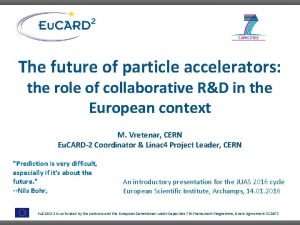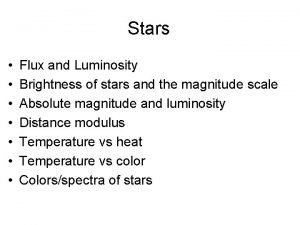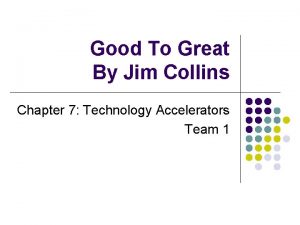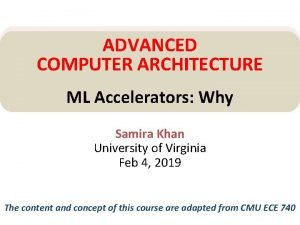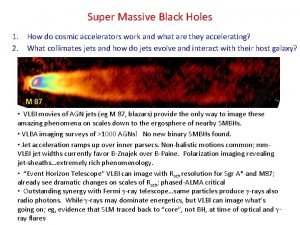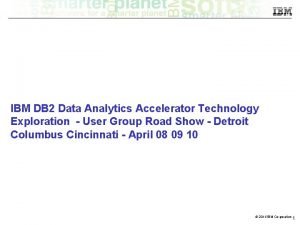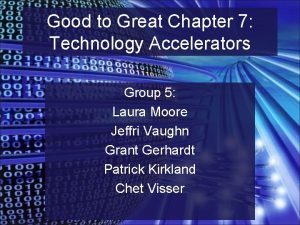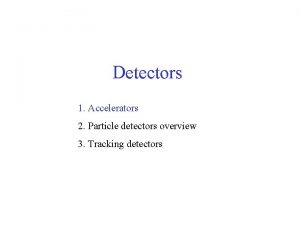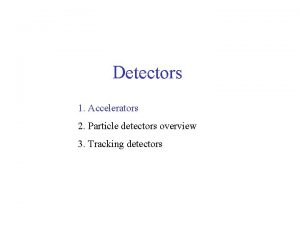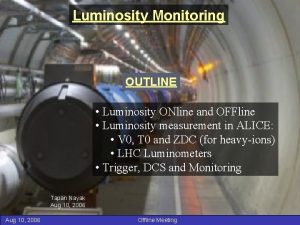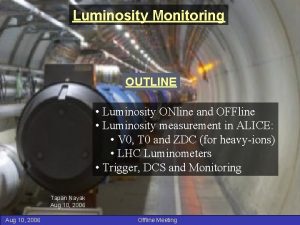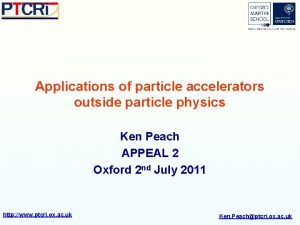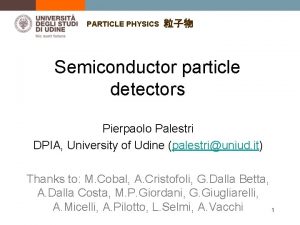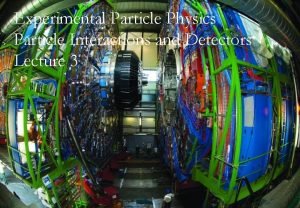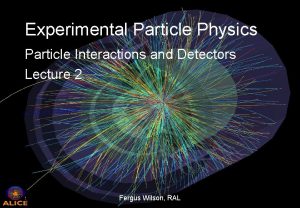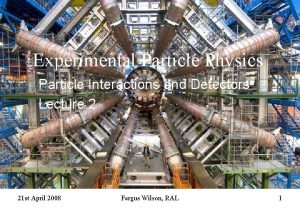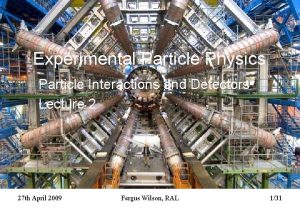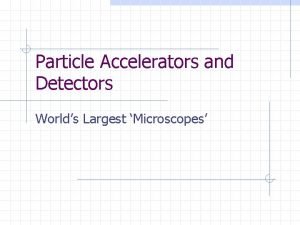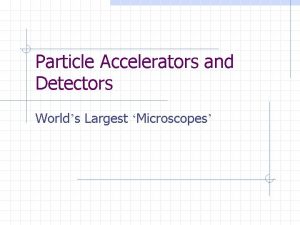Particle Physics 4 th Handout Accelerators Detectors Luminosity



















- Slides: 19

Particle Physics 4 th Handout Accelerators & Detectors • Luminosity and cross-sections • Fixed target vs collider • linac vs circular • Detectors: fixed target, collider • Detector elements http: //ppewww. ph. gla. ac. uk/~parkes/teaching/PP/PP. html Chris Parkes

High Energies in Accelerators • Produce new particles – e. g. W, Z, – … Higgs ? • Probe small scale structure – p=h/λ, e. g. proton structure

Accelerators • Electric Fields to accelerate stable charged particles to high energy • Simplest Machine – d. c. high V source – 20 Me. V beam • High frequency a. c. voltage – Time to give particles successive kicks Fermilab linac > Me. V Energy speed ~c, hence length of tubes same Linear Accelerator - Linac

Synchrotron B field (bending) and E-field (accelerating cavity) Synchronised with particle velocity • pp, ep collider – need different magnets • p anti-p, or e-e+ – One set of magnets, one vacuum tube – LEP (e+e-), Tevatron(p anti-p) • Need to produce anti-particles – Positron – OK, anti-protons difficult – from proton nucleus collisons radius 4

Accelerating Cavities • International Linear Collider plan for 35 MV/m • Length for 500 Ge. V beams ? Niobium, superconducting Magnets 1200 dipole superconducting (1. 9 K) magnets, 14. 3 m long, 8. 35 T Proton energy 7 Te. V, minimum ring circumference ?

Energy considerations: 1)Fixed Target vs Collider • • • Energy – Achieve higher sqrt(s) at collider • Direct new particle searches Stable particles – Colliding beam expts use p, e- (muons? ) Rate – Higher luminosity at fixed target 2) Linac vs synchrotron • Linac Energy – length & voltage per cavity • Synchrotron Energy – Radius, max B-field – Synchrotron radiation Higher E = bigger machine

Energy: Fixed Target Experiment b at rest: Eb=mb for Energy: Colliding Beam Symmetric beams – lab frame =CM frame Particle & anti-particle collision 7

Synchrotron Radiation Energy lost as particles bent to travel in circle is radius of curvature of orbit So for relativistic particles β 1 Limits energy for a electron/positron machine < ~ 100 Ge. V/beam Hence, LHC proton collider Also a useful source of high energy photons for material studies Diamond Synchrotron started operation recently in Oxfordshire 8

Synchrotron: Beam Stability • Particles accelerated in bunches LHC N=1010 • Particle accelerated just enough to keep radius constant – in reality… • Synchrotron Oscillations – Movement of particles wrt bunch – out of phase with ideal, stability ensured Early V C Particle B arriving early receives a larger RF pulse moves to a larger orbit and arrives later next time Particle C arriving late received smaller acceleration, smaller orbit, earlier next time

Focussing • Particles also move in transverse plane – Betatron oscillations – Origin - natural divergence of the originally injected beam and small asymmetries in magnetic fields. • Beams focussed using quadropole magnets. +ve particle Focussing in vertical/ horizontal planes Force towards centre of magnet. Alternate vertical / horizontal net focussing effect in both planes. N. B. Dipoles=bending, Quadropoles=focussing into paper

Cooling Particle accelerator • Initially particles have a wide spread of momentum and angle of emission at production • Need to “cool” to bunch • One methods – stochastic cooling used at CERN for anti-protons • Sense average deviation of particles from ideal orbit • Provide corrective kick • Note particles travelling at c and so does electrical signal !

Cross-Sections We perform an experiment: Smashing beam into a target How many pions do we expect to see ? µDuration of expt(t) µVolume of target seen by beam (V) µDensity of p in target ( ) µBeam incident /sec/Unit area (I) µSolid angle of detector ( Ω) µEfficiency of experiment (trigger/analysis) ( ) µ (I t) (V ) Ω N µ(1/Area)(No) Ω The constant of proportionality – the bit with the real physics in ! – is the differential cross-section Integration over 4 gives total cross-section Can divide total xsec into different reactions e. g. xsec measured in barn, pb etc… 12

Luminosity For colliding beams no V (target volume) term. Require two narrow beams with complete overlap at collision point Typical beam sizes 10 -100 m in xy and cm in z Interaction rate is jn s-1 n 1, n 2 are number of particles in a bunch f is the frequency of collisions e. g. rotation in circular collider, this can be high, LHC 40 MHz! a is the bunch area of overlap at collision point (100% overlap) is known as the luminosity LHC plans up to 1034 cm-2 s-1 Linac – one shot machine Synchrotron – particles circulate for many hours Fixed target luminosity can be higher e. g. 1012 p on 1 m long liquid-H target gives~1037 cm-2 s-1 Number of events = lumi x xsec x time Typically good machine running time is ~1/3 yr (1 x 107 s) 13

Electrons vs Protons ? • Useful centre-of-mass energy electron vs proton • Proton is composite, ~10% root(s) useful energy • 100 Ge. V LEP, 1 Te. V Tevatron had similar reach • Electron-positron much cleaner environment – No extra particles – Can detect missing energy e. g. neutrinos, new neutral particles • Proton – Higher energies, less synchrotron radiation – Electron-positron – “high precision machine” – Proton-proton – “discovery machine” LEP Event Tevatron Event

A typical modern particle physics experiment DELPHI experiment @ LEP collider 15

Example Particle Detector- ATLAS Detector Components: Tracking systems, ECAL/HCAL, muon system + magnet – several Tesla - momentum measurement Tracking: Spatial Resolution 5 -200 m ECAL: Energy Resolution HCAL: Time Resolution: LHC 40 Mz=25 ns 16

Elements of Detector System • Sensitive Detector Elements: e. g. • Tracking - silicon sensors, gaseous ionisation detectors • Calorimeters – lead, scintillators • Electronic readout: e. g. • Custom designed integrated circuits, custom pcbs, • Cables, power supplies. Computing in HEP • Support Services: e. g. Each event 100 k. B-1 MB • Mechanical supports 1000 MB/s, 1 PB/year • Cooling Cannot analyse on • Trigger System • LHC 40 MHz, write to disk 2 k. HZ single cluster Worldwide computing • Which events to take ? Grid • Parallel processing, pipelines • Trigger levels • Add more detector components at higher levels

Example Neutrino Detector But not all detectors look like previous examples Example – neutrino detector Super-Kamiokande • Very large volume half-fill with water • Low data rate 50, 00 tonnes of water 11000 photomultiplier tubes Neutrinos interact Chereknov light cone given off and detected by photomultipliers 18

Accelerator Summary Considerations for an accelerator. • Reaction to be produced • Energy required • Luminosity required • Events expected Particles are accelerated by electric field cavities. Achievable Electric fields few MV/m Higher energy = longer machine Fixed target expt. – not energy efficient but sometimes unavoidable (e. g. neutrino expts) Particles are bent into circles by magnetic fields. Synchrotron radiation – photons radiated as particle travels in circle E lost increases with 4, so heavy particles or bigger ring Or straight line… Synchrotron oscillations controlled by rf acceleration Quadropole magnets used to focus beams in transverse plane Linac – repetition rate slower as beams are not circulating Synchrotron – beams can circulate for several hours 19
 The long-term future of particle accelerators
The long-term future of particle accelerators Frontier detectors for frontier physics
Frontier detectors for frontier physics Luminosity vs flux
Luminosity vs flux Good to great presentation
Good to great presentation Accelerators computer architecture
Accelerators computer architecture Cosmic super accelerators
Cosmic super accelerators Slidetodoc
Slidetodoc Set current query acceleration
Set current query acceleration Good to great technology accelerators
Good to great technology accelerators Gravitational wave hear murmurs universe
Gravitational wave hear murmurs universe Yodsawalai chodpathumwan
Yodsawalai chodpathumwan Nuclear detectors
Nuclear detectors Feature detectors ap psychology
Feature detectors ap psychology Streaming current detectors
Streaming current detectors What is thermal detector
What is thermal detector Detectors used in hplc
Detectors used in hplc Feature vectors
Feature vectors Vhv voltage detectors
Vhv voltage detectors Giant wave detectors murmurs universe
Giant wave detectors murmurs universe Feature detectors
Feature detectors
